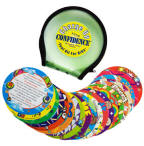

Bullyproof Your Child
for Life
Anti-Bullying Resource Library - Respect U.
Bullying on the Sports Field
Fair Play vs. Foul Play.
Appropriate Behavior vs. Inappropriate Behavior.
Youth. Schools. Camps. Sports.
What do these things have in common? BULLYING! and it is a big problem! Think back to your own memories of school, camp or playing sports and see what you remember about your own bullying experiences.
Bullying statistics can be really scary when you look at the number of people who have been bullied, bullies themselves or observers of bullying (bystanders). Up to 90+ percent of children have either been victims or observers of bullying, and 1 out of 5 kids report frequent bullying that makes their life miserable.
On the playing field in the sports world a fine line exists between competitive play and bullying. Another way to make this distinction is to talk about the line between fair play and foul play. I created a chart that provides a clear definition of bullying in the sports world to help team members become more aware of when they are crossing the line in an inappropriate way.
Bullying is when one or more team members (the bully or bullies) target a single other person (the victim) and use behavior that has the intention to hurt that person. The bully must have power over the victim and have intent to harm the victim. There are 3 types of bullying: physical, verbal and relational. Physical bullying is the easiest to identify and what most of us know as bullying. This consists of hitting, slapping, head butting, towel snapping, tripping, physical violence against another’s will, etc. Verbal bullying includes name calling, unwanted nicknames, making fun of others, taunting, rudeness and threats of violence or harm to another, etc. Relational bullying can be excluding another player, gossiping, “talking trash” meant to hurt another, embarrassment of a player in front of others, etc.
These types of bullying all hurt and can leave long-lasting scars for the victims. The ultimate use of power by a bully against a victim both on and off the field and the intent of the bully to use his/her power to harm the victim is the place we draw the line between fair play and foul play. For example, “talking-trash” may be fine when it is done in fun and there is no intent to harm and no power imbalance that can be exploited. At the same time, playing fair doesn’t mean making another kid with less power, talent or ability feel terrible about themselves. That is foul play. When the line gets crossed it is important that someone step in and stop it because it may escalate into the foul play zone.
In every bully situation, there is a bully, a victim and an observer or group of observers. Since bullying is about power, the bully needs an audience to earn more power. Bullies exploit a victim by seeking out some vulnerability in the less powerful child. Bullies look for other kids who let this happen (bystanders) and do not intervene, because this sanctions the bully to continue. The sad part is that bystanders who let bullying happen and do not intervene begin to think that the less powerful victim actually deserves to be ostracized. Thus, the bystanders justify the bullies’ behavior. In reality, they don’t want to be bullied, and feel relieved someone else is being picked on. The message to the victim of this is clear: you deserve this! The victim feels broken down again. A victim may suffer a loss of interest in sports, self-esteem, anxiety and withdrawal from social activities.
Bullies we now know can be smart, popular, and socially skilled. However, they are more comfortable using aggression and have little empathy for their victims. 60% of bullies who go unchecked in life have a criminal record by their mid-twenties.
How do we know if our children are being bullied on the sports field? It is important to look for changes in behavior in our children. For example, is there a shift away from a loved sport, friendship with another child, or disinterest in going out and playing. Does your child report physical concerns like stomach aches, or pain? Parents can ask their child some important questions as part of their regular discussions: Who do you hang out with on the team? Do you have a good friend, or have someone to eat with every day? Have you ever seen bullying on the team, like someone being teased? Have you ever been picked on? Have you picked on someone else on the team? By asking the right questions, we can find out more about the bully situation.
Now, the question is what are we to do if bullying is going on. Parents need to be an advocate for their kids and help kids stand up on their own. Coaches need to set the tone for the kids on a team and not stand for the kind of behavior that looks, feels and smells like foul play. If coaches model bully behavior or allow it to occur, their teams breed the very kind of foul play that spoils a child’s experience in sports and having fun. Lastly, the bystanders play a major role. I’ve listened to countless kids, teens, and adults talk about their experiences watching other people get bullied and then feeling guilty and anxious because they didn’t intervene. My training model is to geared towards encouraging these bystanders to be “team heroes” by stepping in and helping to create environments where bullying simply isn’t tolerated.
The earlier we intervene and work with athletes to be “good team players” and help coaches learn the difference between “fair play and foul play”, the better job we’ll do to correct the power imbalance in bullying and have a truly competitive experience for our children in sports.
copyright © 2009-2011 by RespectU.com. All rights reserved.
terms of use - privacy policy

